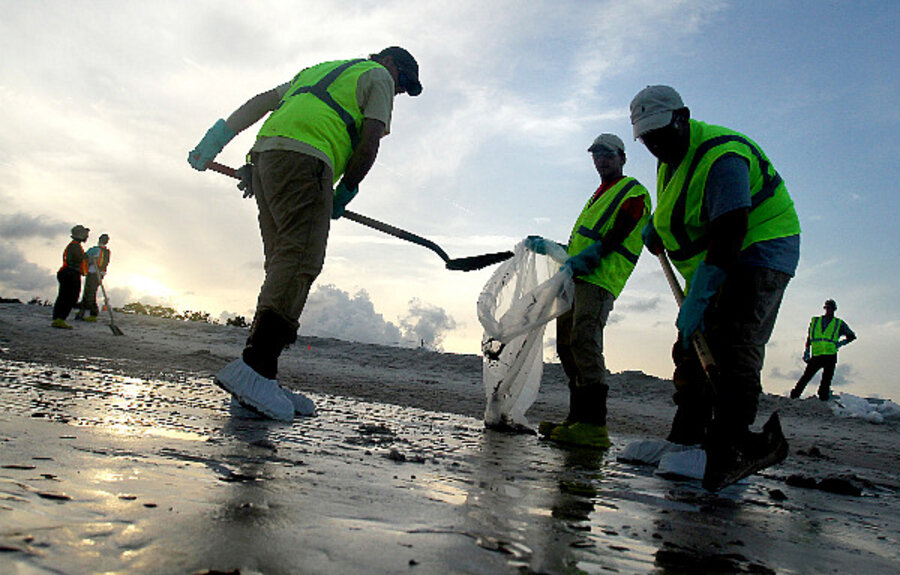Top Kill 2: BP aims to turn off Gulf oil spill spigot soon
Loading...
| Atlanta
The Gulf oil spill drama is heating up this weekend. Call it Top Kill 2.
Coast Guard Adm. Thad Allen gave the thumbs-up Saturday to a proposal by BP to temporarily stop the runaway Macondo well now in its 80th day spewing up to 60,000 barrels of oil a day into the Gulf of Mexico.
The maneuver requires the company's robot proxies at the bottom of the Gulf to remove the current containment cap, which was placed on the well last month and is siphoning up to 25,000 barrels of oil a day to ships on the surface. That means the geyser will gush unabated before the new cap is slipped over the top of the faulty blow-out preventer on the seafloor a mile beneath the Gulf.
IN PICTURES: The Gulf oil spill's impact on nature
The tighter fitting cap will be attached to a newly-arrived vessel, the Helix Producer, which, along with two ships currently storing and burning oil, could increase the total oil-capture capacity to 53,000 barrels of oil a day, possibly containing all of the oil spewing from the well.
If successful, the cap will also give scientists the most accurate measure yet of the geyser's exact flow rate, which will be critical in determining final damages that BP and potentially some of its subcontractors will have to pay as a result of the spill.
BP and Coast Guard estimates of the well flow rate have gone from 1,000 barrels a day to between 35,000 and 60,000 barrels a day since the Deepwater Horizon rig sank on April 22, two days after an explosive blow-out on the rig killed 11 workers.
Adm. Allen said Friday that he gave the go-ahead to the new capping effort because of the potential capacity increase as well as the appearance of a window of calm weather in an otherwise stormy summer that has impacted both collection and skimming operations.
The new cap procedure is not without risks.
Unforeseen difficulties have already overcome half dozen different strategies to halt the leak. And BP's prediction that a major spill in the Gulf would "have no adverse effects" has been stubbornly countermanded by the sheer geologic force of the geyser.
Besides killing hundreds, possibly thousands, of sea creatures, the spill has effectively cancelled summer for many Gulf beach and fishing communities as oil has washed up on beaches and shorelines and closed nearly 80 percent of the Gulf's fishing zone. Last month, BP agreed to set aside a $20 billion escrow fund to help "make the Gulf whole," but the total amount and the vagaries of the claims process are unlikely to fully compensate economic and ecological losses from the spill.
Even before the Deepwater Horizon rig sank, BP has consistently seen the spill through "rose-colored glasses," says Rep. Edward Markey (D) of Massachusetts. Earlier suggestions by BP that two relief wells now being bored could completely kill the well by July 15, Markey says, coincided with a scheduled July 27 BP second quarter earnings report. BP response chief Bob Dudley has said a July completion of the relief wells is "unlikely."
BP's shares rose 1.3 percent overnight. BP's stock value has dropped 43 percent since the Deepwater Horizon rig sank, as of Friday. Closing the well sooner rather than later could be critical to BP's survival, some analysts have said.
Criticized by local officials for a slow and piecemeal response to the spill, the Obama administration, a 51 percent partner in the joint spill response, hopes that slumping polls on the government's response will turn around once the Macondo well is silenced.
The cleanup, however, could take years, and the White House response to the spill is already becoming a factor in the upcoming congressional elections in November.
IN PICTURES: The Gulf oil spill's impact on nature
Related:
Gulf oil spill: Two weekend operations could boost oil collection
BP oil spill: Relief well is ahead of schedule, close to target
Obama loses in court again over deepwater drilling moratorium





